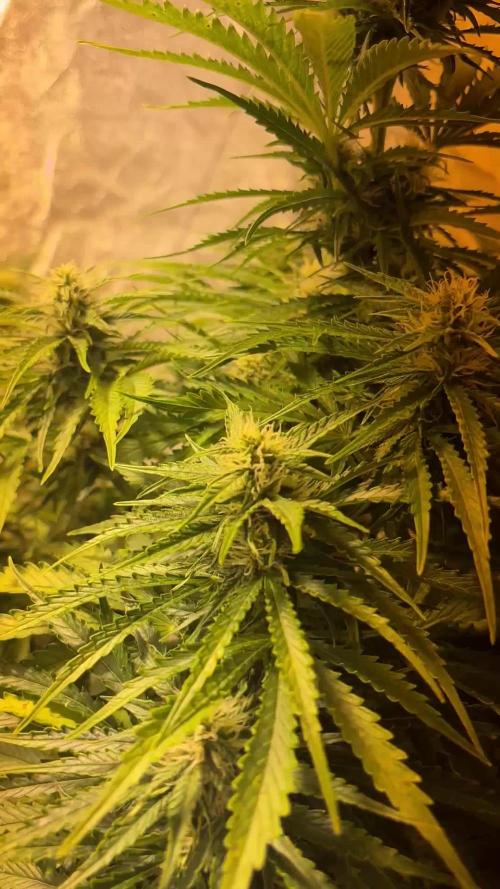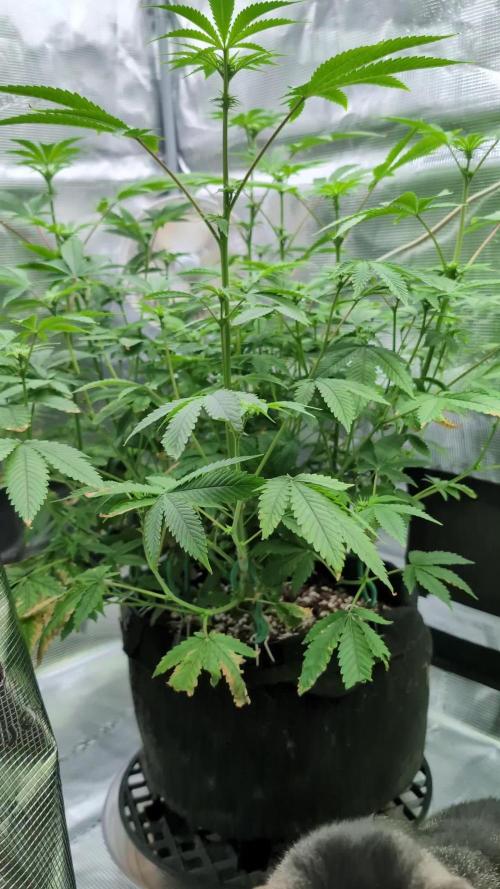The Grow Awards 2026 🏆 

































Likes
Comments
Share


@Hou_Stone
Follow
👌It’s progressing, slowly but surely for my 4 young banana krumble 👶🍌
For this grow, I plan to let each plant grow with a large main bud, without topping.
Next week I will cut the lower branches closest to the ground.
-----------------------------------------------------------
💧Watering:
1L on day 9 and 0.5L on day 12
I use tap water, adjust the ph to around 5.8 and water
------------------------------------------------------------
🤩Equipment of the week :
Light FC3000 Mars hydro. power 80% at 50cm
Extractor 6 inch Mars Hydro. power 1/10. ON 24/24h
2 fans to circulate the air inside the tent. Each on for 30 minutes then off for 1 hour. this rhythm repeats itself in a loop
Heating mat Romberg 95x95cm. ON 45 minutes. OFF 30minutes. In a loop
I am adding anti-midge bird stickers 🐦
------------------------------------------------------------
Thank you for your visit and your support with the likes, comments. It's always nice to see you!💚
------------------------------------------------------------
My Instagram 🌱❤️️ :
https://www.instagram.com/hou_stone420/
Processing
Likes
30
Share


@CBD_Sweden
Follow
2018-04-10 Day 1
I gave the girls water and nutrients yesterday so nothing to drink today.
Turned them 90 degrees today, to give my girls as much lightexposure as possible.
The flowers get bigger and bigger for each day,
Overall the ladies look really good, the colors are very nice, they look healthy.
Sour Ripper nr 1 is 79cm
Sour Ripper nr 2 is 77cm
Added some new videos of the girls, check them out 👌
--------------------------------------------------------------------------------------------------
Strain information
After much effort Ripper seeds can introduce one of the most appreciated varieties by genetic collectors.
They have worked to get one of the few lines of Sour Diesel feminized version preserving the main qualities of a good Sour D: flavor and potency.
Sour Ripper has a sativa structure with a wide distance between branches, little foliage and a more compact and desirable bud than the Original Sour Diesel we work.
It's flowering period is 65-70 days.
The most "undergrown" taste of the United States available for your collection.
Vegetative: 1 to 2 weeks
Genotype: 60% Sativa / 40% Índica
Indoor flowering: 65/70 days.
Outdoor flowering: Mid October
Yield: Medium / High
Effect: Powerful.
--------------------------------------------------------------------------------------------------
Likes
1
Share


@Bones_1986
Follow
Day 50.
Very annoyed at myself as 2/3 plants needed a strong feed, but the other one didn’t but forgot and fed the strong feed to all 3. As a result the 1 what was already thriving has now foxtailed on the main cola. Such a shame, but lesson learned.
That plant will have just a water feed for the next week, and PH run off was also high at 6.8 also contributing to the foxtail I’m guessing so next few feeds will be PH at 6.0.
Another 15 - 20 days to go I’m guessing, I will now be swapping big bud out for overdrive, really make these swell to the finish line.
Likes
120
Share


@NugLife420
Follow
Well, these ladies are growing like weeds! 😃
I am getting ready to do their second topping. They seem to be taking nutrients well. I am planning on vegging them out for at least 3 more weeks. Going to have some monsters! 😎 Sincerely, thanks for all the support. 🙂
Likes
19
Share


@Canna_Enthusiast
Follow
As expected the signs of deficiency started to dissappear once the roots were formed
D19: topped #1
D21: did some cleaning of the roots of #1
D22: topped #2 and switched the light to 20/4
Processing
Likes
8
Share


@Chronicbastard
Follow
These girls are starting to really stack on the trics.the are all looking very healthy,no burnt tips.i did snap a couple bottom branch's half off so I had to fix those,so that kinda sucks.i really need to learn how to be a little more careful.lol
Likes
18
Share


@Grow420pice
Follow
Über Ostern jetzt hatten wir sooo gutes Wetter... Ich konnte nicht wiederstehen und hab Sie nach draußen gebracht... Sie liebt es.
Bis dann growmies
🌱💚💪😎
Likes
25
Share


@m0use
Follow
Left these ones out a bit to long and not nearly enough love, so they suffered a bit but that's ok. I am going to experiment and try water curing the buds. First time ever using this method and I think it will make a good little project. No idea how to it will turn out, been reading it will remove most of the smells and that sucks but the smoke is very clean and light. Only time will tell. take about 7 days to fully water cure. bud washing helped get rid of a lot of extra that stuck to them outside.
Likes
2
Share


@eldruida_lamota
Follow
Vamos familia, actualizamos la quinta semana de floración de estas Runtr de MSNL.
La temperatura que estuvo entre los 24-26 grados y humedad dentro de los rangos correctos.
En cuanto a las plantas las veo verde sano, estiraron bien y ensancharon bastante también.
Se nota que los nutrientes de la marca Agrobeta, añadí Thor y Mega Pk, hacen sus funciones.
Las flores empezaron a engordar y a llenarse de tricomas, por el momento todo correcto, os dejé también alguna novedad y un cambio en la sala, agradecer al equipo de Mars hydro por el nuevo TSW2000. (los últimos 5 años cultive solo con los leds de esta marca).
- os dejo por aquí un CÓDIGO: Eldruida
Descuento para la tienda de MARS HYDRO.
https://www.mars-hydro.com
Hasta aquí todo, Buenos humos 💨💨💨
Likes
73
Share


@Fatnastyz
Follow
Day 64 - Day 17 - 9/16
- 18" today
- 483 ppm @ 6.0 ph, gave 4000ml, runoff was 600 @ 6.0ph.
- Added Power buds, slf, and royal rush to this batch
Day 65 - Day 18 - 9/17
- 19"
- Gave a calmag flush today. 4000ml of RO and 2ml cal mag, 190ppm @ 6.1 ph. Runoff 550ppm @ 5.9ph.
Day 66 - Day 19 - 9/18
- 20" tall!
- 493 ppm @ 6.0 ph, Runoff after 4000ml is 617 ppm @ 5.8ph.
- Still stacking, guess I'll go back down on the ppm
Day 67 - Day 20 - 9/19
- 20.5"...only a half inch...whaaaat?!
- 422 ppm @ 6.0 ph. Gave 5 liters! yeah...a lot! Runoff 575ppm @ 5.8ph.
Day 68 - Day 21 - 9/20
- 21.5"....an inch! Whooo
- 411ppm @ 6.0ph, 3000ml, runoff 48 ppm @5.7 ph.
- Still needs lower...
Day 69 - Day 22 - 9/21
- 23"...yes!!!
- 409 ppm @ 6.1 ph. 4000ml, runoff 527ppm @ 5.8ph
- closer....still needs lower
- Week 4 starts today!!!
Day 70 - Day 23 - 9/22
- 24"
- 386 ppm @ 6.0 ph. 3000ml. Runoff 512 ppm @ 5.7 ph.
- Will still go lower tomorrow.
**So, the Terra is for nasty-ass dirt LOL, and its running hot in my coco, having a hard time getting it low enough for her. Seems she doesn't like above like 300ppm right now. Will keep lowering.
Need to start a bit of Green Sensation soon and she still need a defoil lol. She's pretty bushy. Will get to that hopefully Sunday.
August Midnights is being his typical adorable self! Always wanting to play! Love this kitty soooo much! He was meant to be our baby. A year ago, just 2 weeks into October, someone posted this little black kitty free to good home. I never even get posts from this group on my feed....but for some reason, there it was! Terrified, and in disbelief that someone would offer a free black kitten so close to Halloween, I knew he was meant for us! And...on top of that, he was actually born in August, so the name I wanted for my next kitty was PERFECT, then him being solid black....I had my perfect Swiftie Cat name! August Midnights. Can't believe he's a year old now. He just grew up so fast, crazy how time flies.
Likes
7
Share


@Stifler
Follow
No big changes this week, some pistils have started to mature, I believe that starting today she will get fat! 😀
The smell started to get stronger this week too, the aroma resembles coffee with pine! 😋
Likes
9
Share


@PopsFarm
Follow
Day 52 - Deep Jealousy Auto from @anesiaseeds
Nutrients: @atami_deutschland / @atami.international / @stefan_atami / @daniel_atami
Soil: @promixgrowers_eur / @promixgrowers_global / @promixgrowers_unfiltered / @promixmitch
LED: @powerlux_spain
Tent: @secretjardin_
Thank you to everyone who follows and supports my work 🙏🏻💚
This means a lot to me and you should know you are a part of it and only with you all this is possible, you are the best community 😎
Growers love, love for everyone
Likes
15
Share


@Luv2Grow
Follow
Day 50 - Starting week 8 and she’s looking amazing so far. Went ahead and did a little more defoliating, not much but trying to keep the middle of her and some of the lower bud sites that didn’t get even with everything else some light. I’ll continue doing some light defoliating every day or so till I’ve got her where she needs to be. Should be ready for some water in another day or two.
Day 51 - Nothing much new today but did do a little more defoliating and checked the wetness of the soil and all still good and probably needs another couple of days before needing any.
Day 52 - Gave her just under two gallons of plain pH’d water today and next watering she’ll get a round of nutes. Did a little more defoliating today as well and tucked the rest as best I could. She is getting opened up a bit so hopefully some of the lower stuff can start developing a bit and if not, I’ll end up doing a partial harvest, when it’s time and chop the rest after it develops more but still a ways off from that.
Day 54 - No major updates really today, just did a little more leaf tucking and gave her a once over. She’s really starting to fatten up and getting really shiny with all the trichs. Held off on any defoliating today and will probably continue with a little tomorrow.
Day 55 - Just did a bit more leaf tucking with her today and will give her a feed of nutrients tomorrow and will probably continue and do a little more defoliating as well.
Day 56 - The end of week 8 and gave her 2 gallons of water and nutes today, she was pretty thirsty and it was time for flower nutes. Didn’t do any defoliating today but did a bunch of leave tucking once I put her back into the tent and plugged the second AGLEX light in so hopefully some more light will need her up these last couple of weeks.
Likes
8
Share


@TheNetherstokeDruid
Follow
New light this week! Not sure what I should expect. I fed the girls early on, but think the feed levels were too strong as they showed signs of pH imbalance again. Flushed them with water, tested pH, low and behold pH too low. After flushing fed with a lighter nutrient mix, which they have both enjoyed since. By the end of the week, it's obvious these girls like the new light. It's promoted some new growth and more bud sites, which will hopefully increase the overall yield.
Going to be fun watching them fatten up over the next couple of weeks or so.
Likes
58
Share


@Legendaryseedthumb
Follow
The development of these girls are a little after compared to the other plants in the tent. But still stretching 💪🏽😁
Likes
101
Share


@SlowpokeFuegobud
Follow
💜 🌧️ 👊💜 🌧️ 👊💜 🌧️ 👊💜 🌧️ 👊💜 🌧️ 👊💜 🌧️ 👊💜 🌧️ 👊
The grow was a pleasure, the smell of the buds is mouthwatering!! 💜 👊
In the middle of the grow perhaps the soil got a bit salty.. the Punch still grew well without getting flushed. She showed signs of calcium deficiency on the leaves which are most addressed by the LED. She recovered easily and delivered delicious flowers. 🙏
The smell during the grow was so good, I couldn't wait for her to finish! 😍 Surely going to grow that one again!! 🍒 😋
I also love sleeping!
Effects are very relaxed. Just sloth. Muscle release, mindfuck release, all included! 😇
Thanks everybody for visiting!! 😘 Grower love!!! 💚 💚 💚
Thanks @Fast_Buds for the great genetics!! ❤️
_________________________________________________________________________________
Strain Description:
This is a giant autoflower that reaches 150cm and produces massive yields of up to 600gr/m2, a modern Cali strain that offers what a top-quality Indica-dominant hybrid should; nugs capped in resin with the density you would expect from Indica-dominant strains and that bag appeal that will surprise even the most experienced growers. Expect beautiful purple and magenta hues that come along with a sweet almost pastry-like taste and, thanks to the 24% THC, a very pleasant and potent effect that surprisingly starts as a motivating high and in no time relaxes you completely, taking a bit of the energetic edge off.
Bud description
Purple Punch Auto develops rounded compact buds with fat calyxes and bright orange or sometimes bright yellow hairs, with copious amounts of trichomes that give the buds that beautiful frosty look that all growers seek for. The light-green buds can exhibit subtle purple or lime-green tones that give them a charming and attractive look and complement them magnificently, while the mouth-watering mix of earthy cherries and blueberry muffins with a spicy touch will win you over even before you can see the buds.
Smoke report
Due to the high THC levels, you’ll experience a powerful effect that will completely relax your whole body and gradually start feeling like all your muscles are melting before you can count to three. Despite the strong Indica effect, you won’t be couch-locked thanks to the slight Sativa genes that incorporate a pleasant creative head-buzz and leaves you mellow and clear-headed in a peaceful state of mind. The perfect effect to go through a busy day stress-free, alleviating sore muscles after a long workout routine or just chill and have fun on a night out with friends.
Plant appearance
Due to the Indica dominancy, this strain remains relatively compact despite its height and grows wide and thick fan leaves typical of Indica-dominant varieties. You can expect a thick tall main cola and a few shorter side branches with spaced-out internodes where the incredibly frostbitten flowers develop and end up looking like buds on steroids by the end of the flowering stage.
Grow tips
This strain offers unique flavors and charming colors so we recommend flushing thoroughly to allow it to show its full potential and end up with the beautiful reddish-purple and/or lime-green hues on the buds and surrounding foliage. Due to the Indica genes, the buds grow denser than usual so it’s essential you tie the branches slightly so there is enough airflow in between the buds to prevent mold and bugs. This variety doesn’t require a lot of maintenance or anything extra but remember to feed her properly and with good-quality nutrients, this way you guarantee the buds fatten up properly and that your plant doesn’t suffer any kind of nutrient deficiencies.
Flavor
Thanks to the high-quality genetics, this strain offers a distinguishable taste of fresh blueberries and earthy cherries with spicy undertones and a pinch of sugary tart. The sweet smoke overpowers your throat with a sweet blueberry muffin-like taste as you inhale and, as you exhale, leaves a delicious coat of sweetness in your mouth that leaves you feeling like you’ve just eaten a dessert.
______________________________________________________________________
SETUP:
80x80x180 cm Zelsius
240W Full Spectrum LED IR UV dimmable
DW240H-A6-HS
Heatsink color red
LED Chips:
512pcs SAMSUNG LM301H + 24pcs Osram 660nm + 8pcs Osram IR 730nm + 8pcs UV 385nm
Color mix: 2700K + 4000K
2,8umol/J
Driver HLG-240H-C2100B
Coverage: veg 5x3ft / flower 4x2ft
Product size: 628x205x68mm
° 2x 5W Fans
° custom 320/270 cm³/h exhaust fan & Carbon Active Granulate 240cm³/h
° Mills Nutrients, Green Buzz Nutrients
Shouts go out to my sponsors @GreenBuzzNutrients, thanks so much for your support! ❤️
If anyone would like to try their amazing organic products, use code GD42025 for generous 25% discount (for orders of minimum 75€) ✨
https://greenbuzznutrients.com/
° tap water EC 0,26uS upgraded to EC 0,5 with PlantMagic MagneCal - pH 8, nutrient solution downgraded to pH 6,5 with Advanced Hydroponics Minus Bloom
° from week 4 in the same container Aptus Enzym+ once a week
° Biobizz Lightmix
💜 🌧️ 👊💜 🌧️ 👊💜 🌧️ 👊💜 🌧️ 👊💜 🌧️ 👊💜 🌧️ 👊💜 🌧️
Likes
6
Share


@ganjaman24
Follow
She grows nice and quick if you Treat her well! I transplanted and made a couple mistakes so she didn’t reach 100% imo but it’s still a nice turn out! Hadn’t she not gotten pollinated I think the yield would’ve been more! Oh well still not a bad turnout will compare her to my other cut of this strain I have finishing up! Check it out, thanks for reading


























